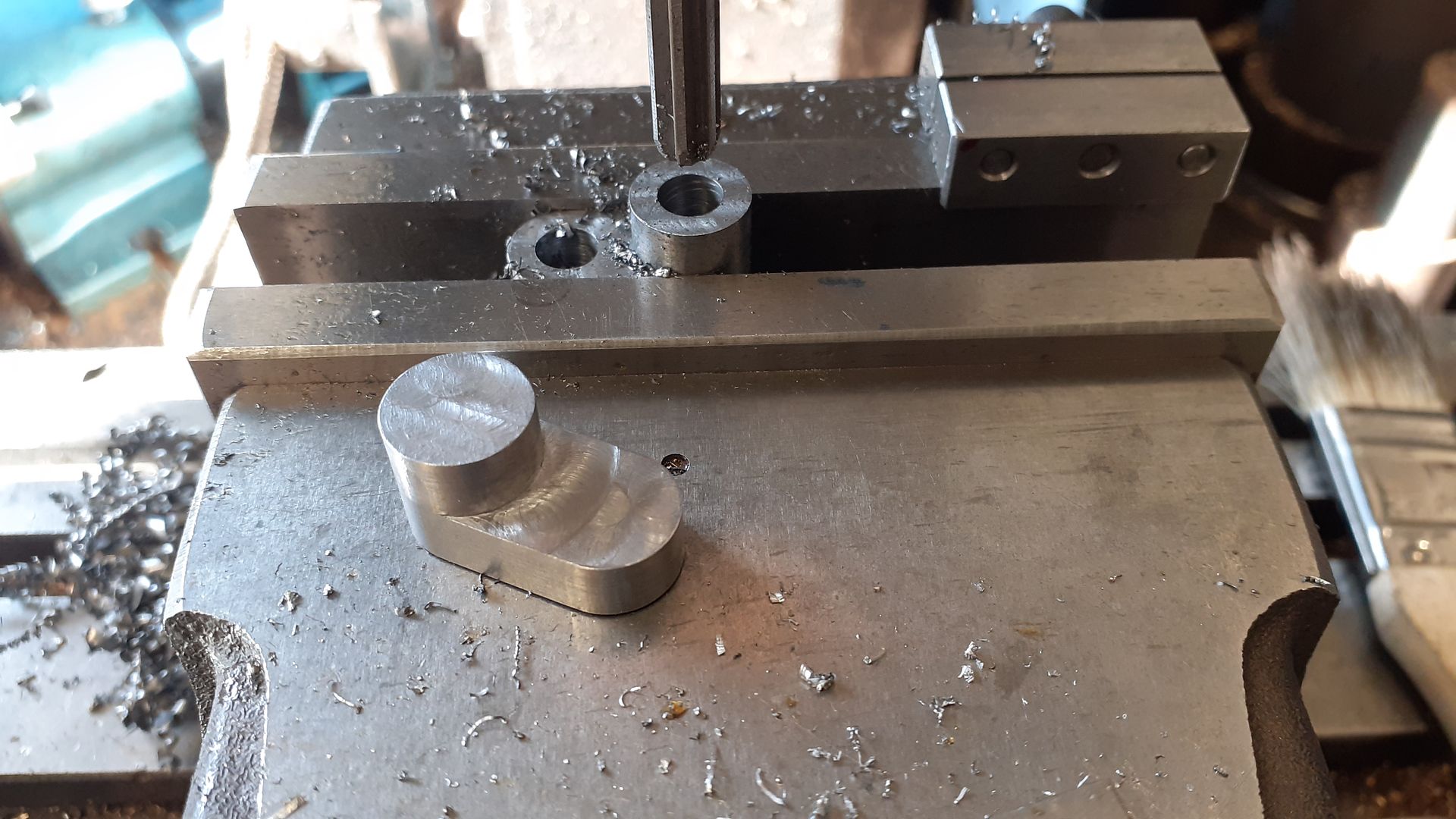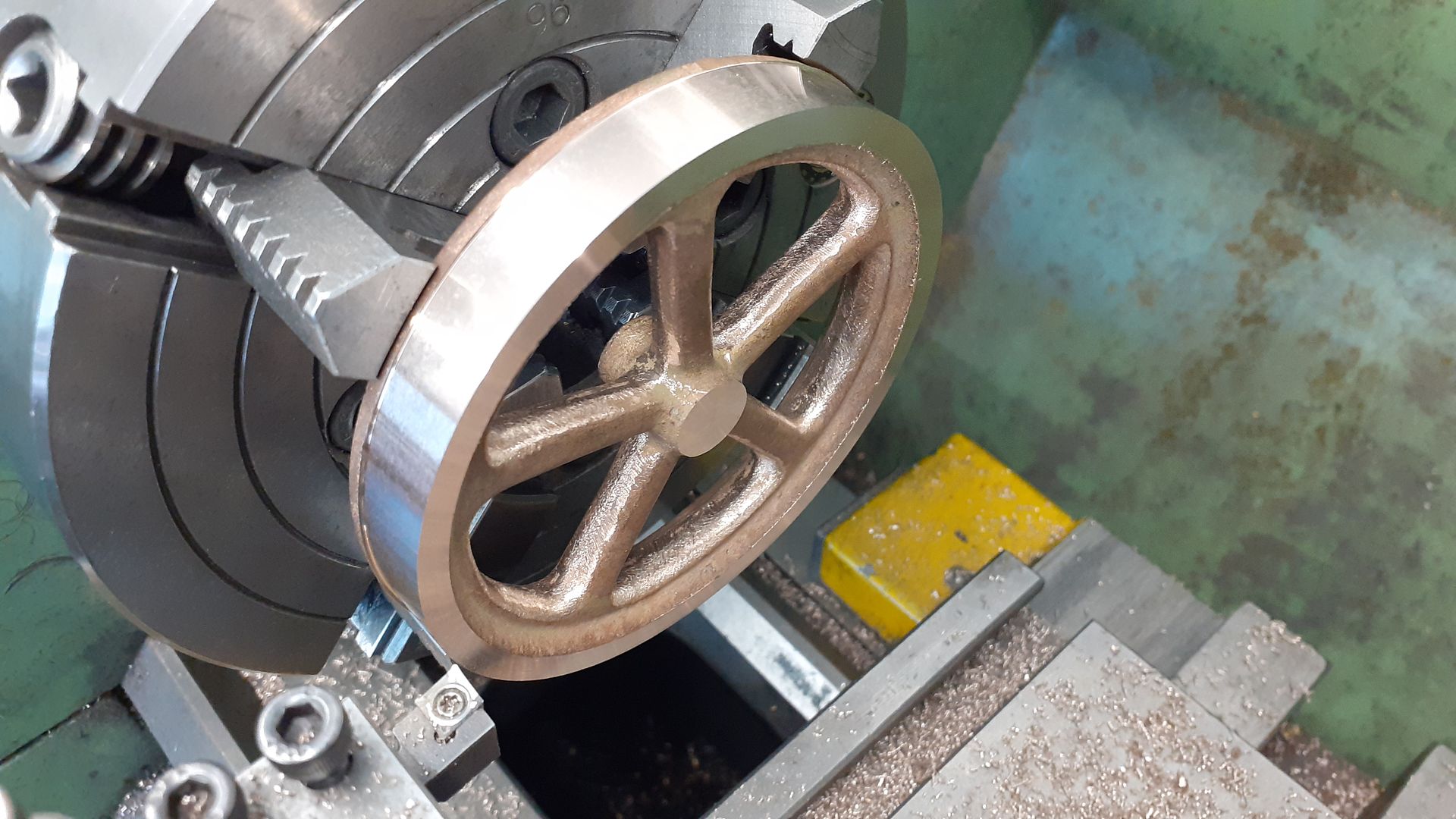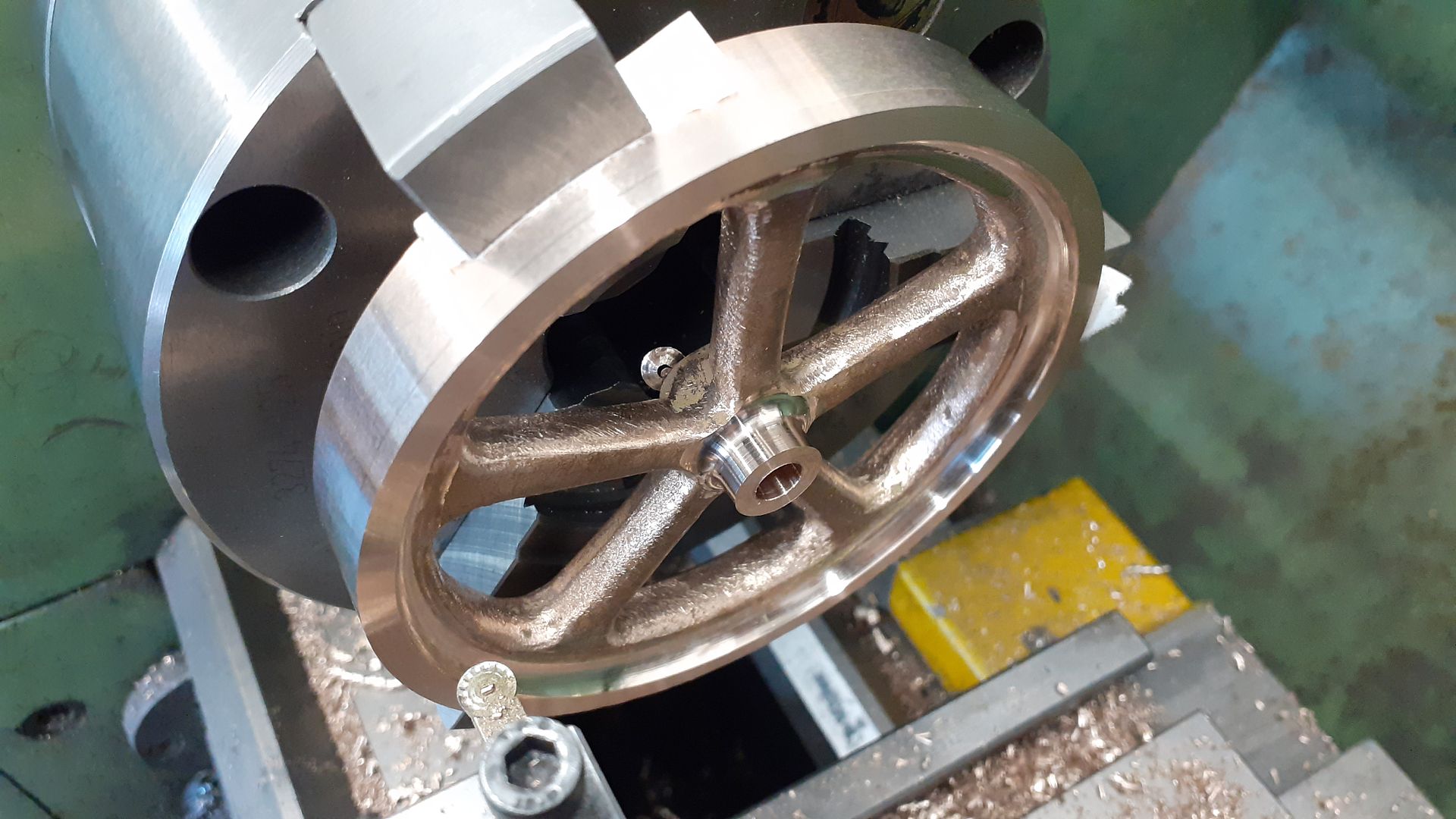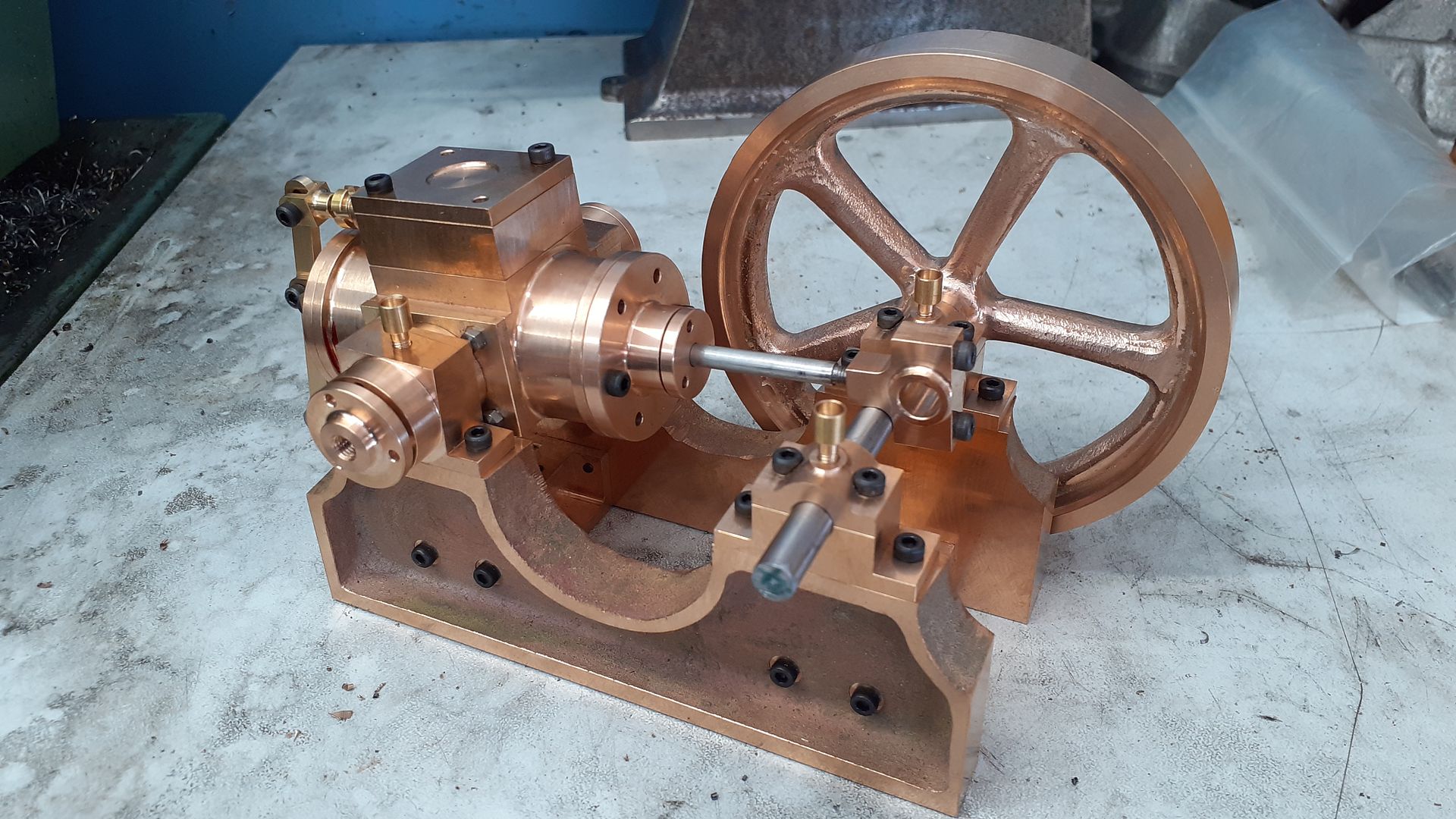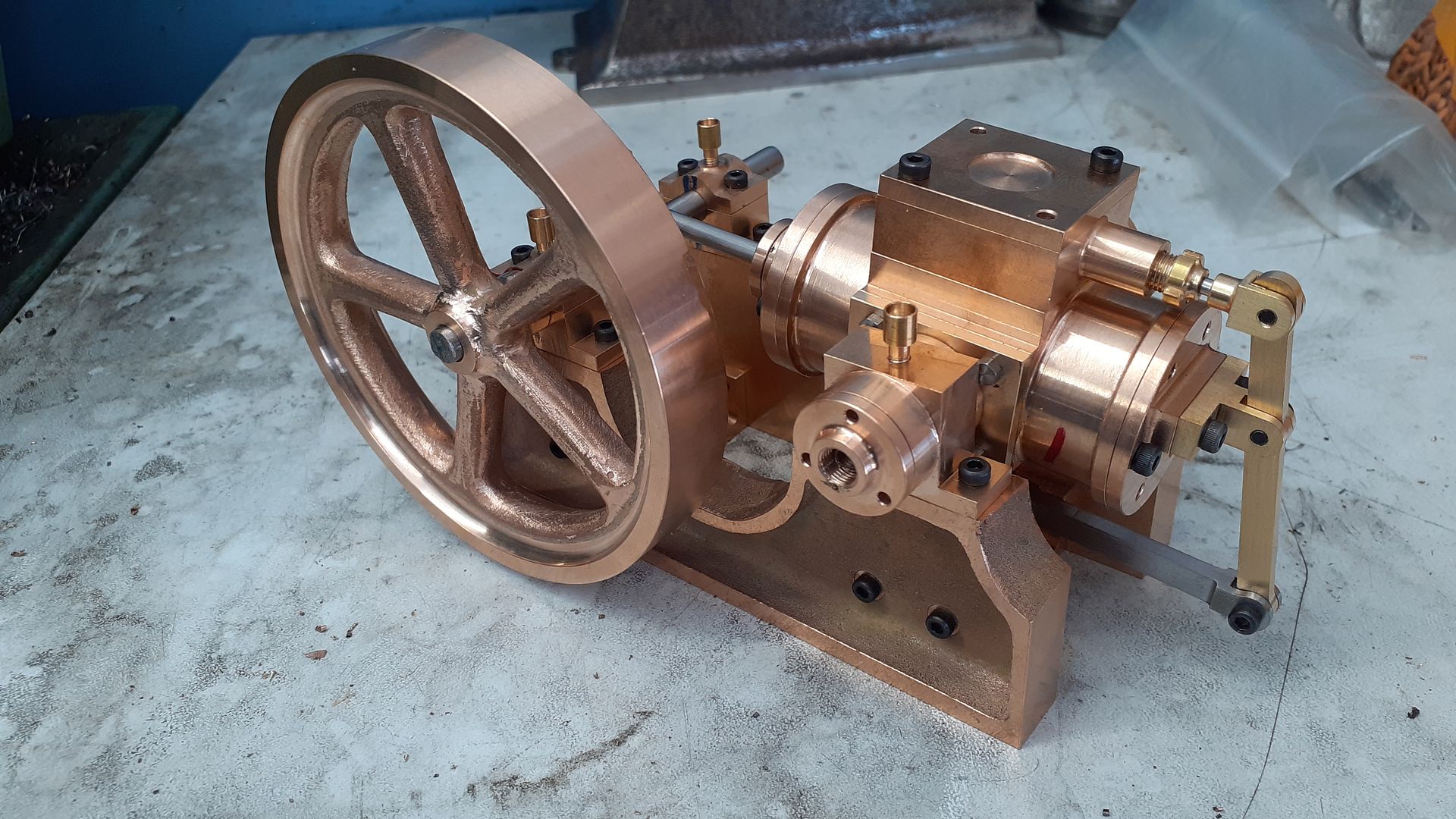The main challenge with the cylinder casting is getting the location of the trunions that fit either side exactly in line and at right angles to the bore, I hatched a plan to do the cylinder and then fit the part machined trunions to that before final machining and almost came a cropper but first lets look at the cylinder.
Like the other castings I took a skim off the flat surfaces first those being the port face and the two trunion mounting faces either side. Here you can see I have at least 0.100″ to play with at the ends and the red lines roughly show the extent of material to come off around the port face.
![20230828_085701[1]](data:image/gif;base64,R0lGODlhAQABAAAAACH5BAEKAAEALAAAAAABAAEAAAICTAEAOw==)
After skimming these faces I had three flat and true surfaces to go against the 4-jaw chuck’s jaws and used an aluminium packer on the curved underside. After facing off and boring the OD of the flange was turned which was actually smaller that the rest of the cast body of the cylinder so to add a bit of shape a round ended tool was used to reduce the area between flange and portface/trunion mount by 1/8″ in diameter, you can just see the generous amount of metal left on the curved surface under the ali packer. The other end was then treated the same.
![20230828_120923[1]](data:image/gif;base64,R0lGODlhAQABAAAAACH5BAEKAAEALAAAAAABAAEAAAICTAEAOw==)
To aid in holding the cylinder casting for some further machining I made one of the end covers at this stage, it was the one with the gland for the piston rod, the boss of which was left over long at this stage to give me more to grip.
![20230828_141931[1]](data:image/gif;base64,R0lGODlhAQABAAAAACH5BAEKAAEALAAAAAABAAEAAAICTAEAOw==)
This group shot shows the current state of play.
![20230828_143704[1]](data:image/gif;base64,R0lGODlhAQABAAAAACH5BAEKAAEALAAAAAABAAEAAAICTAEAOw==)
Next was to drill the two 2mm dia holes to where the inlet ports will be and also the six M2.5 holes for the cylinder cover studs and finally mill a notch so the steam passages connect to the cylinder. This was repeated at both ends.
![20230902_120905[1]](data:image/gif;base64,R0lGODlhAQABAAAAACH5BAEKAAEALAAAAAABAAEAAAICTAEAOw==)
Using some bar in the bore the casting was centered and the port face milled to the correct height above the bore. The width was done at the same setting taking the cut sdown to form the top edge of the trunion mounts Most of the material was removed with the facemill then the final finish cuts with a new carbide 3-flute 6mm cutter using a 4mm stepover. The inlet and exhaust ports were milled at this same setting.
![20230903_090011[1]](data:image/gif;base64,R0lGODlhAQABAAAAACH5BAEKAAEALAAAAAABAAEAAAICTAEAOw==)
The two trunion mounting surfaces were then milled in a similar way. A 5/8″ x 5/32″ deep hole is required to locate a spigot on the trunion so these were plunge cut working up through sevaral sizes of 3-flute cutters actually finishing with a 16mm one as the size is not critical and I’ve more sharp cutters in that size than 5/8″.
![20230903_131849[1]](data:image/gif;base64,R0lGODlhAQABAAAAACH5BAEKAAEALAAAAAABAAEAAAICTAEAOw==)
To mill the curved underside to size I screwed on the end cover and held that in the 5C indexer adding tailstock support to the other end with the addition of a quickly knocked up plug. I also used this setup to drill the steam passages from the trunion recesses to the valve cavity and exhaust port. The angles and hole positions were taken from a section of my cad drawing, there is not much metal to play with.
![20230904_103145[1]](data:image/gif;base64,R0lGODlhAQABAAAAACH5BAEKAAEALAAAAAABAAEAAAICTAEAOw==)
![20230904_103157[1]](data:image/gif;base64,R0lGODlhAQABAAAAACH5BAEKAAEALAAAAAABAAEAAAICTAEAOw==)
![dc[1]](data:image/gif;base64,R0lGODlhAQABAAAAACH5BAEKAAEALAAAAAABAAEAAAICTAEAOw==)
 Ady1.
Ady1.

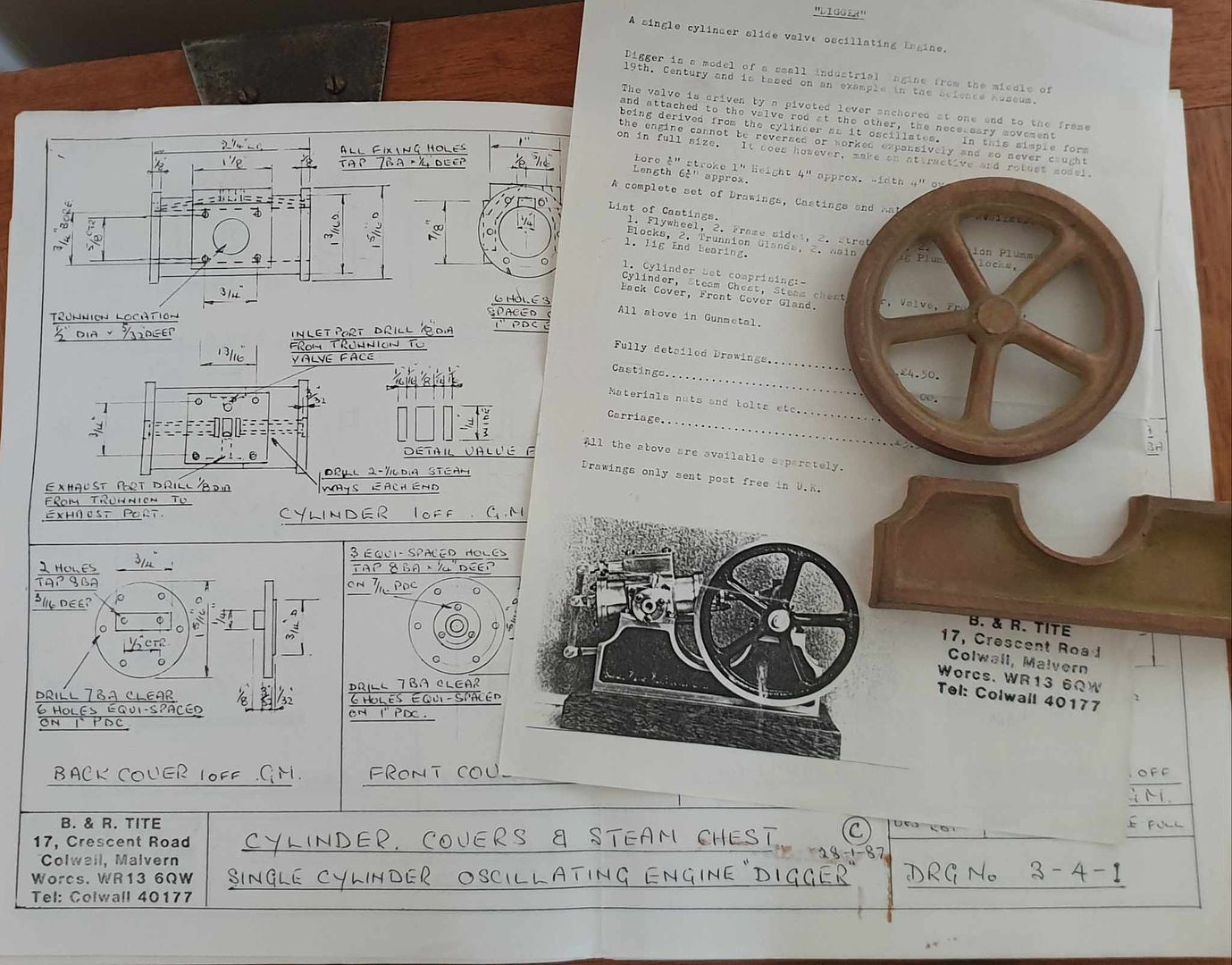
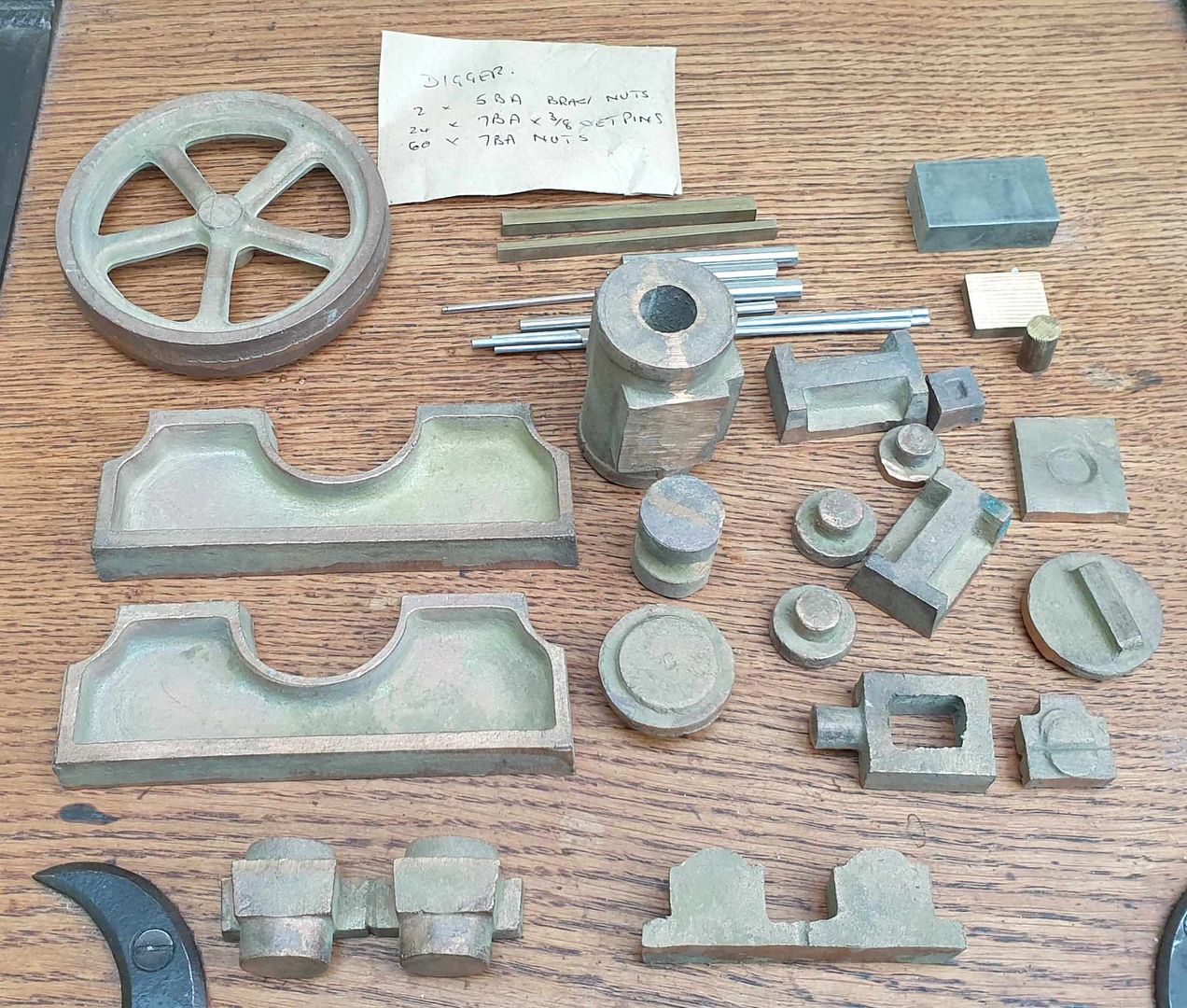
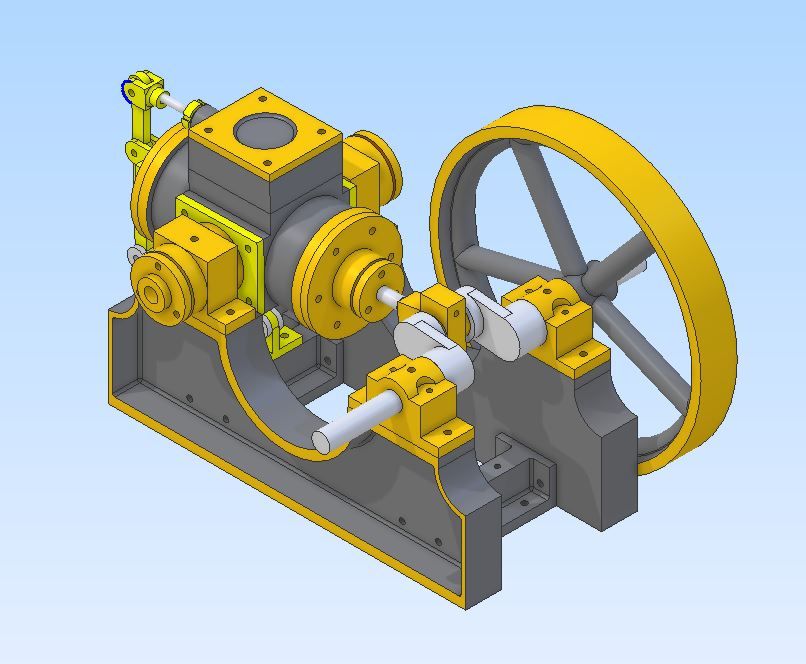
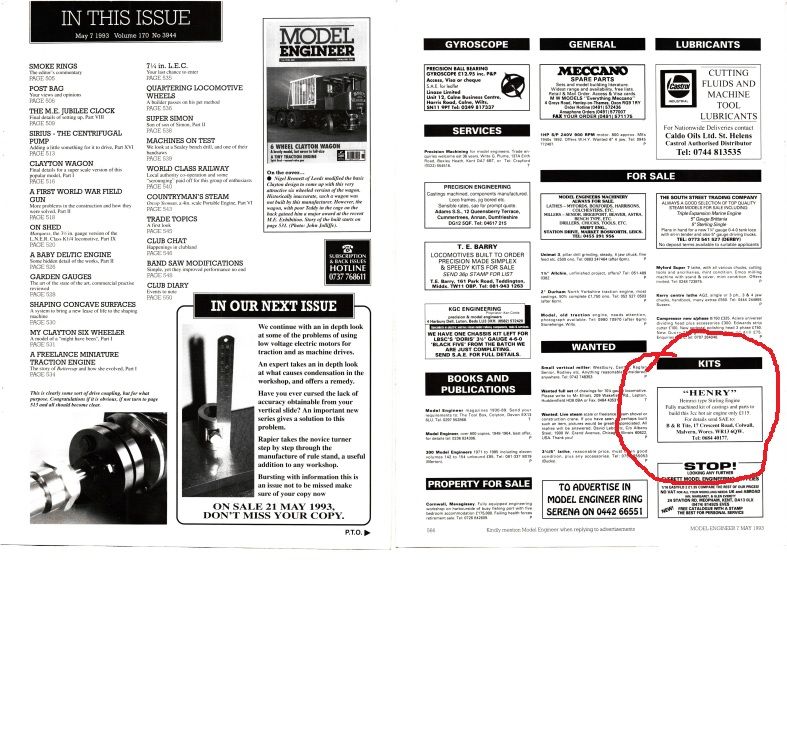

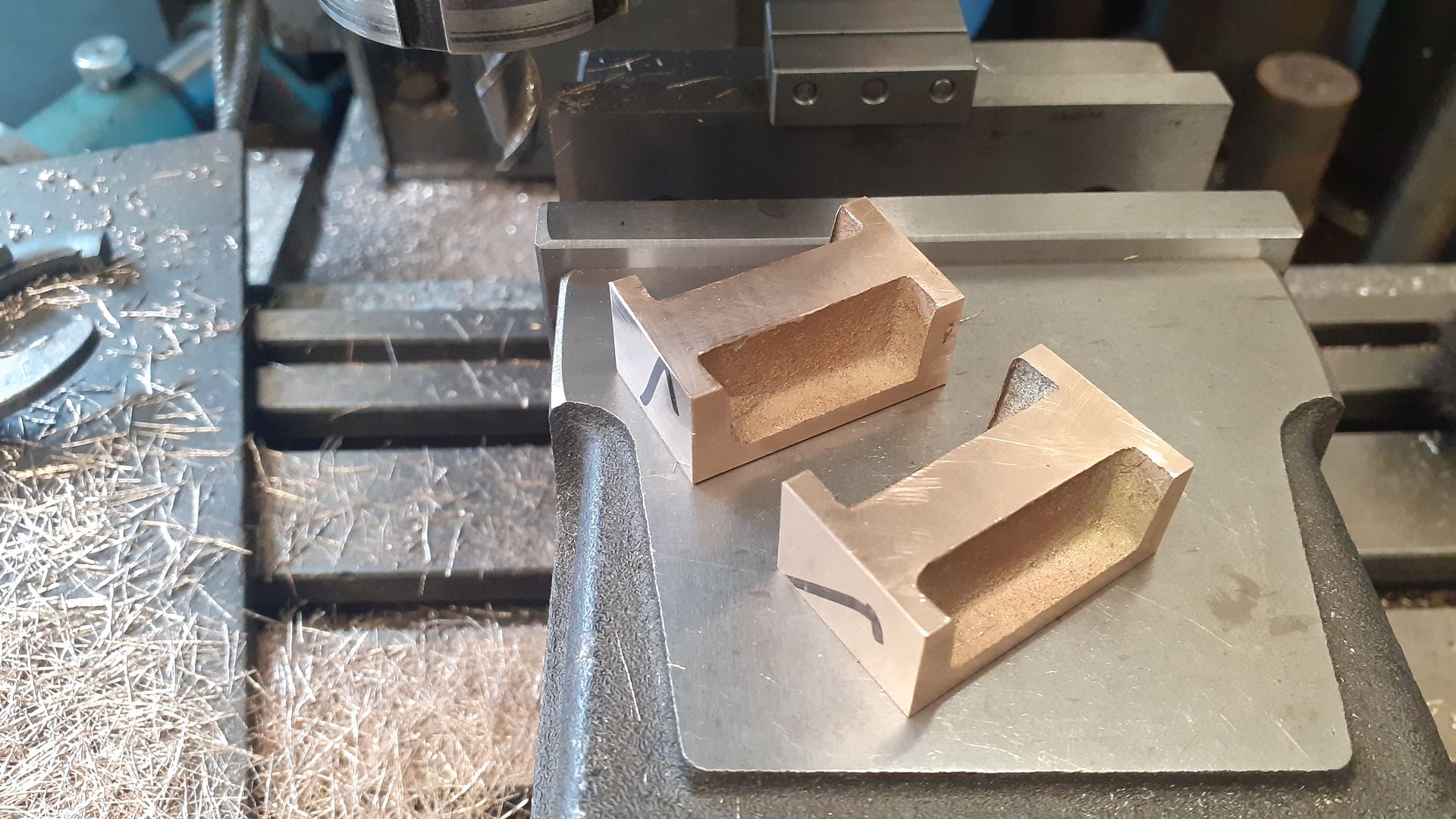
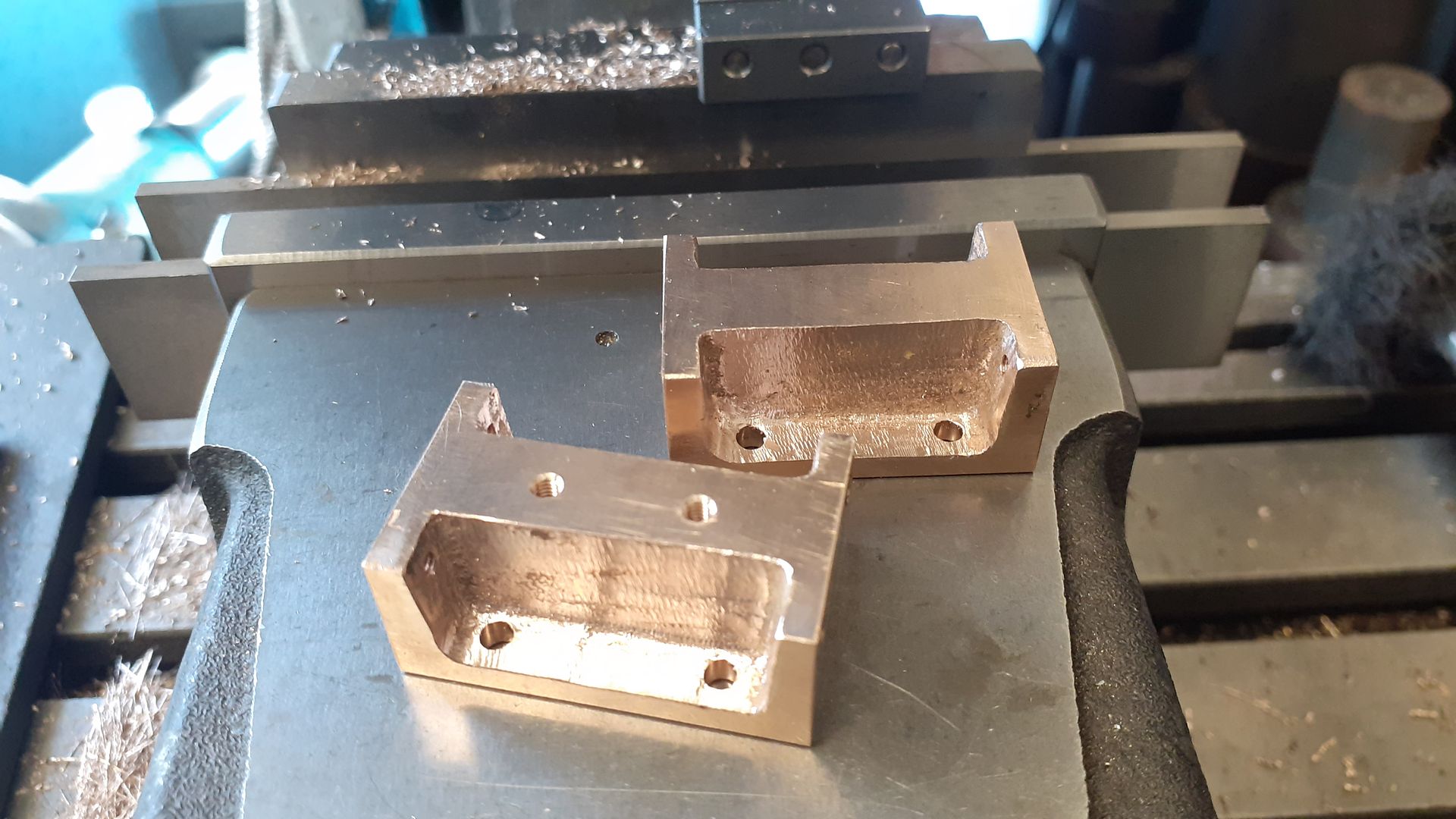
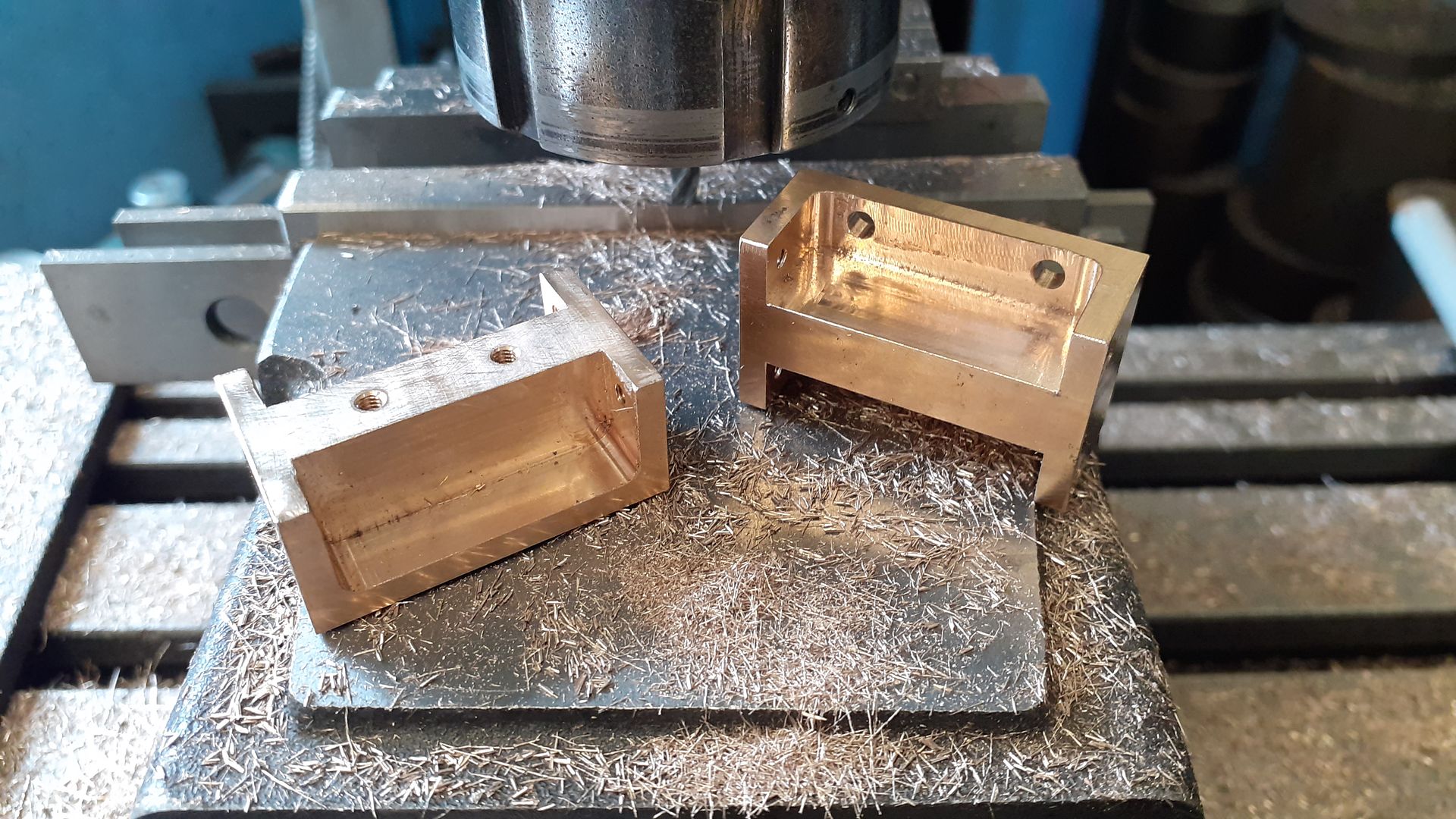
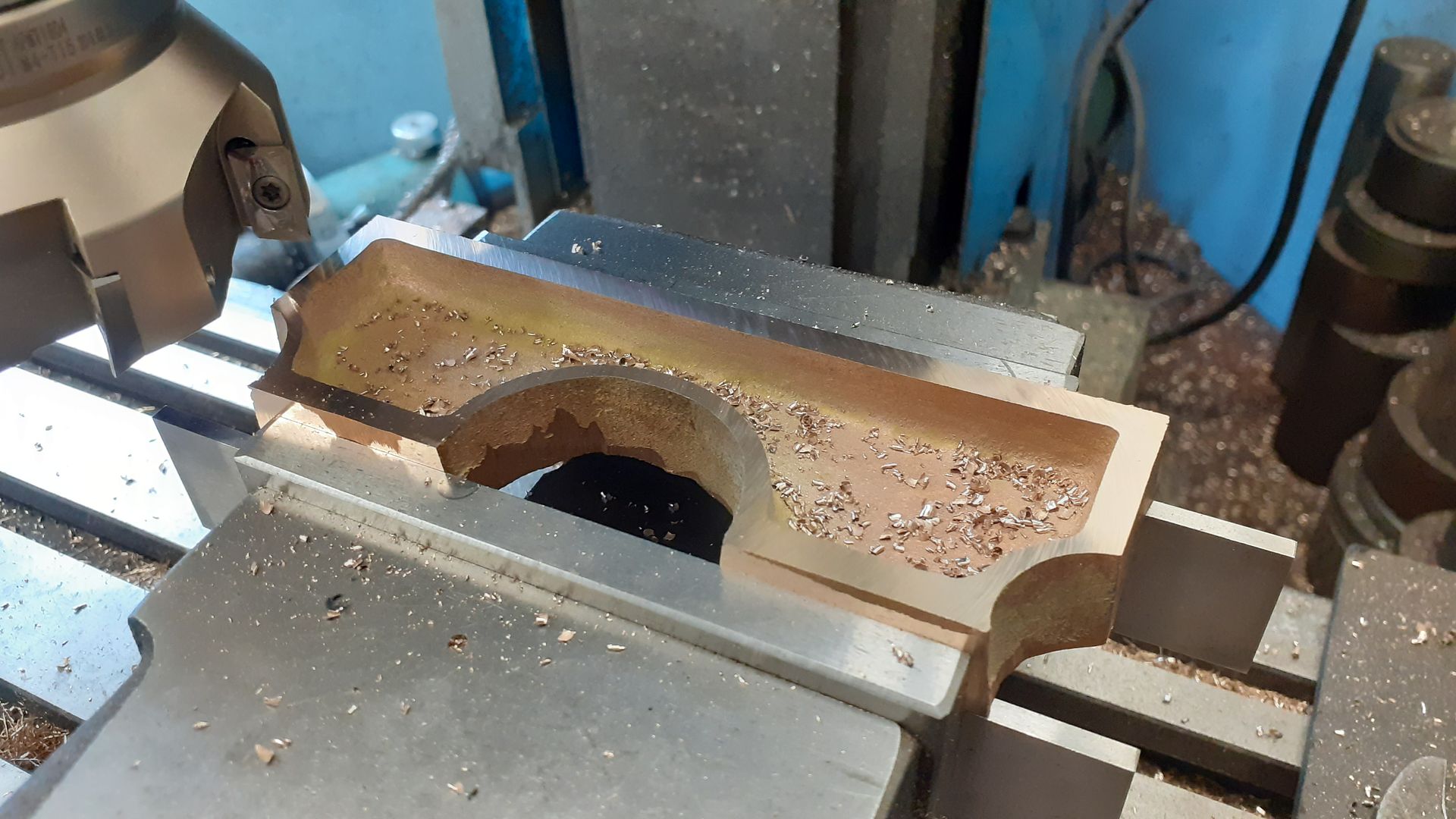
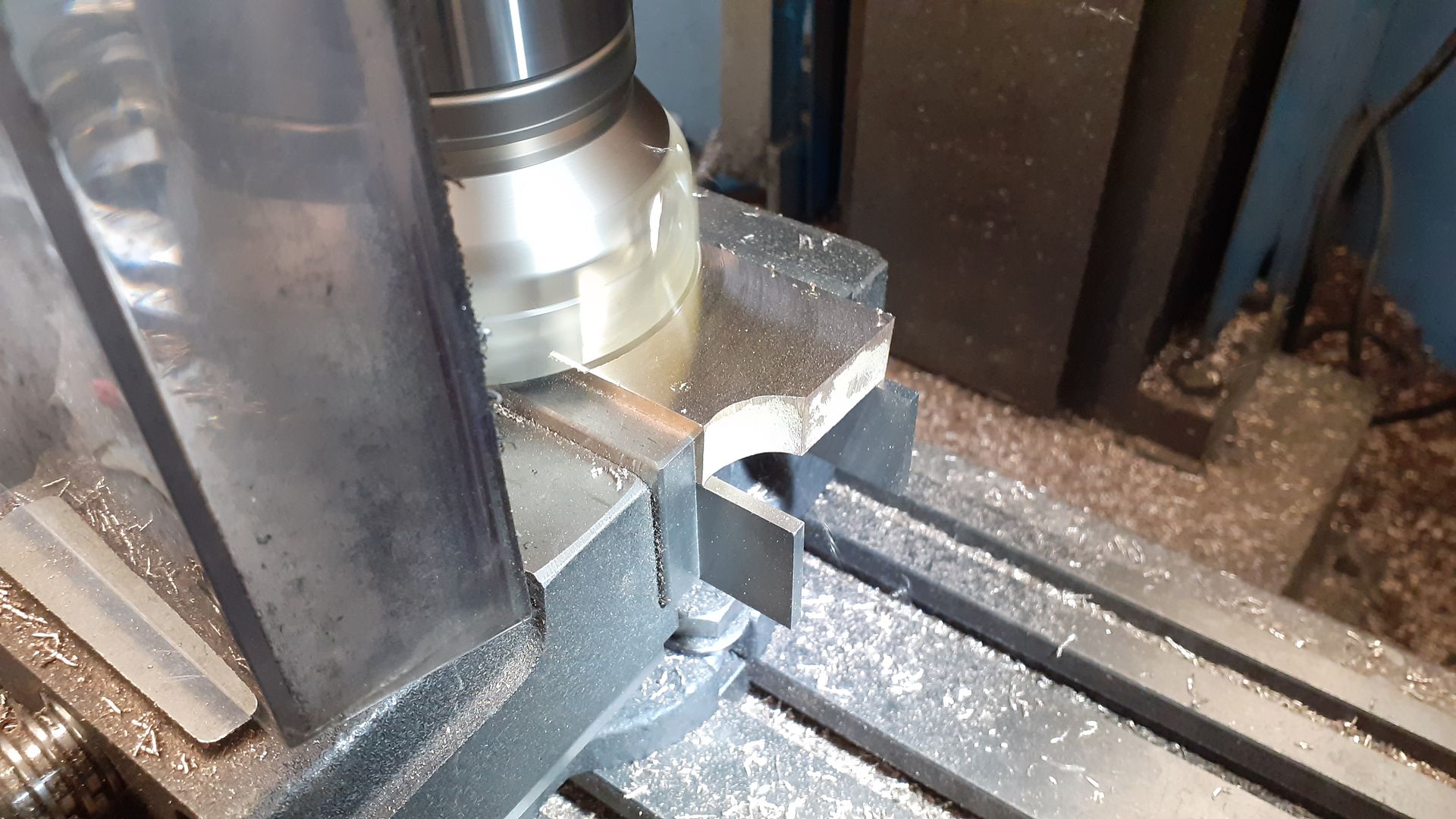

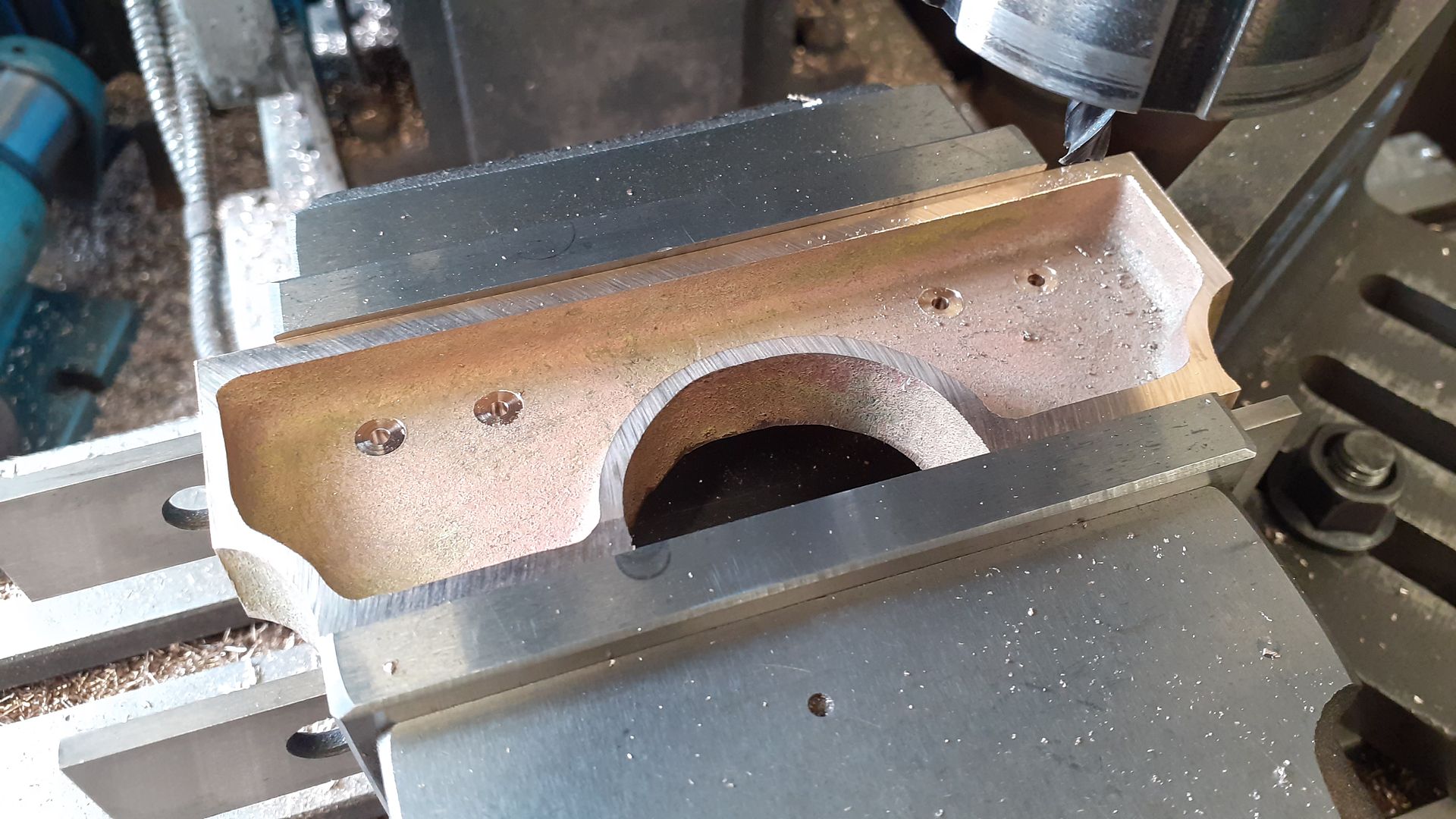

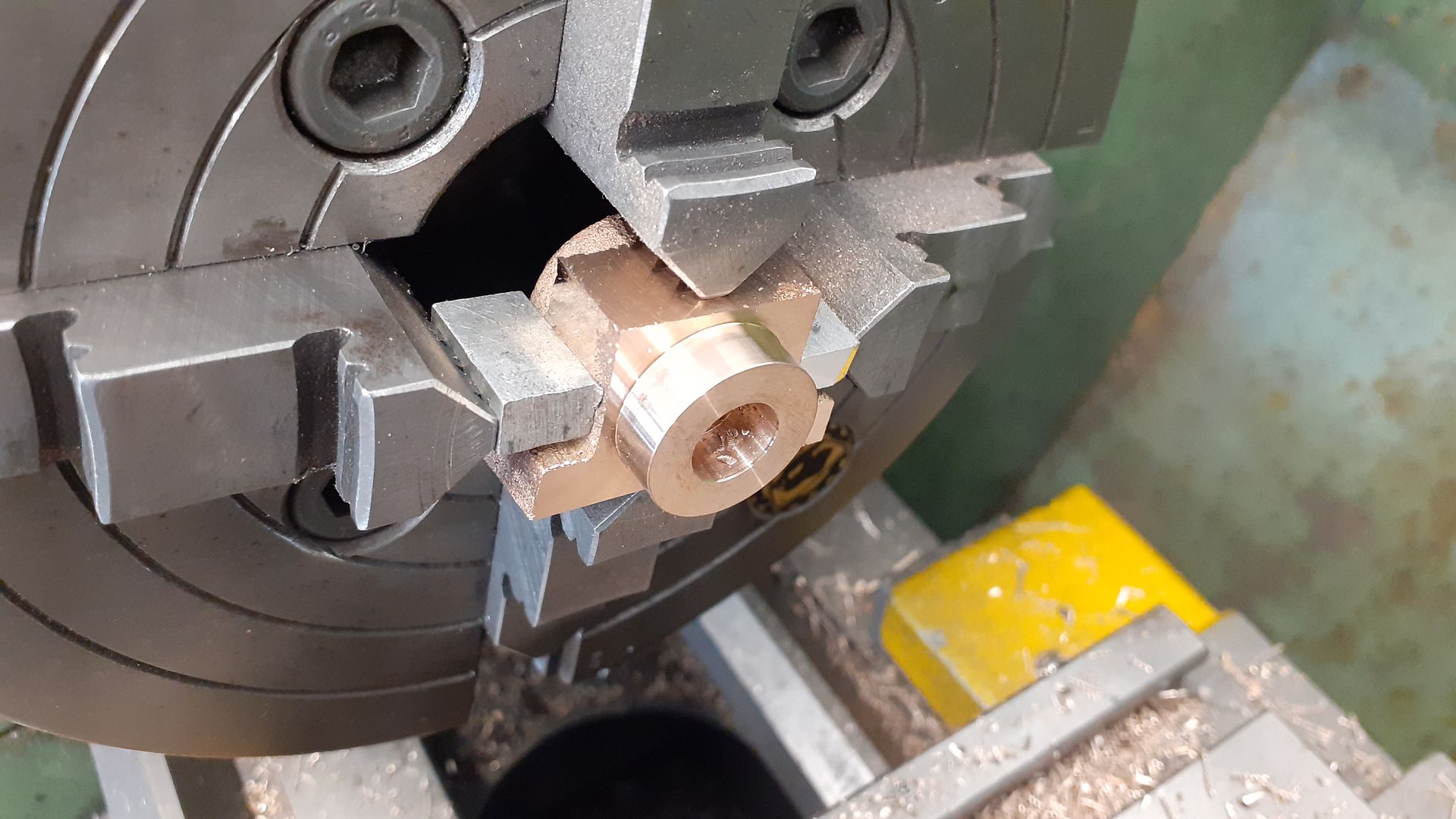
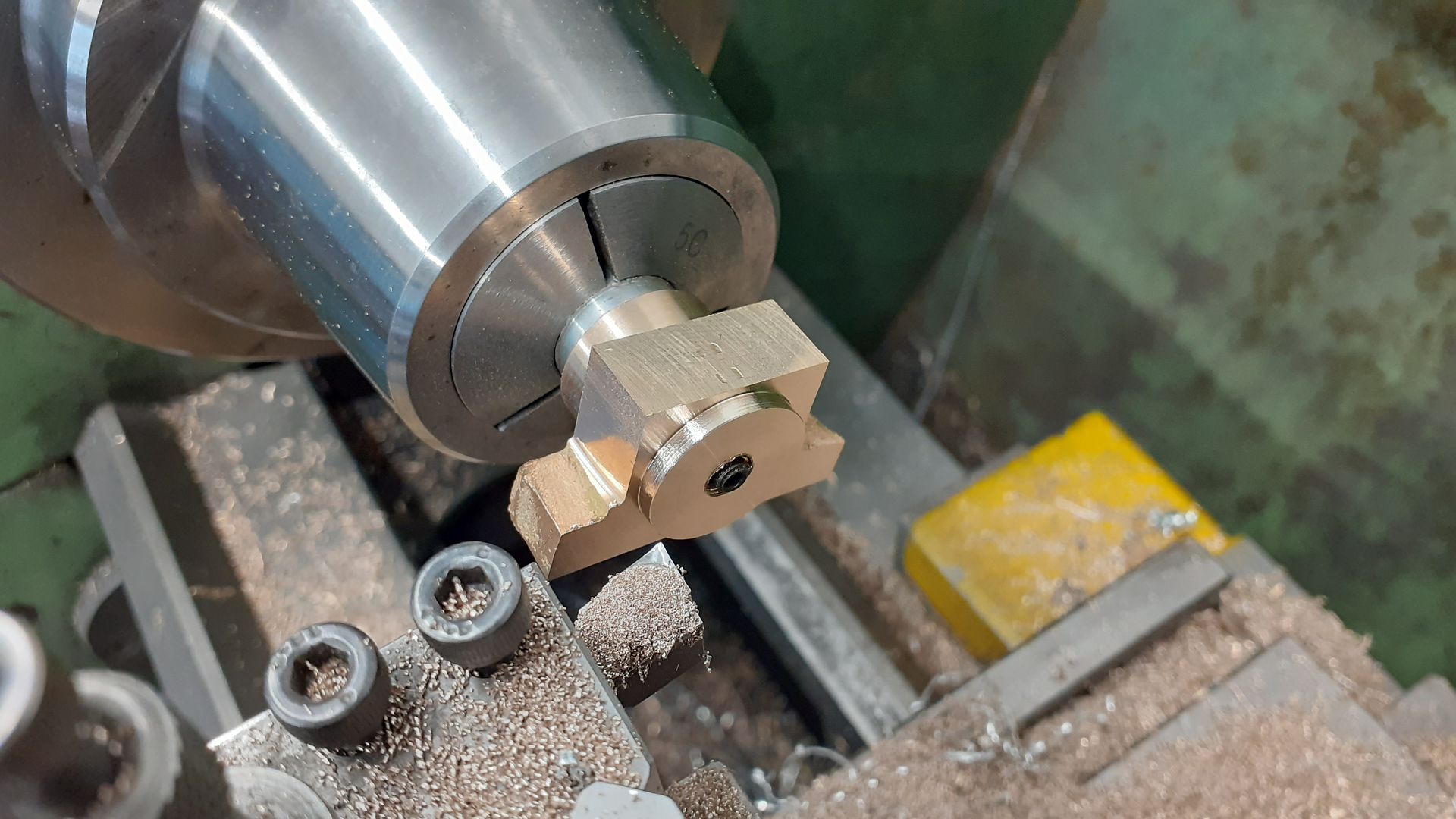

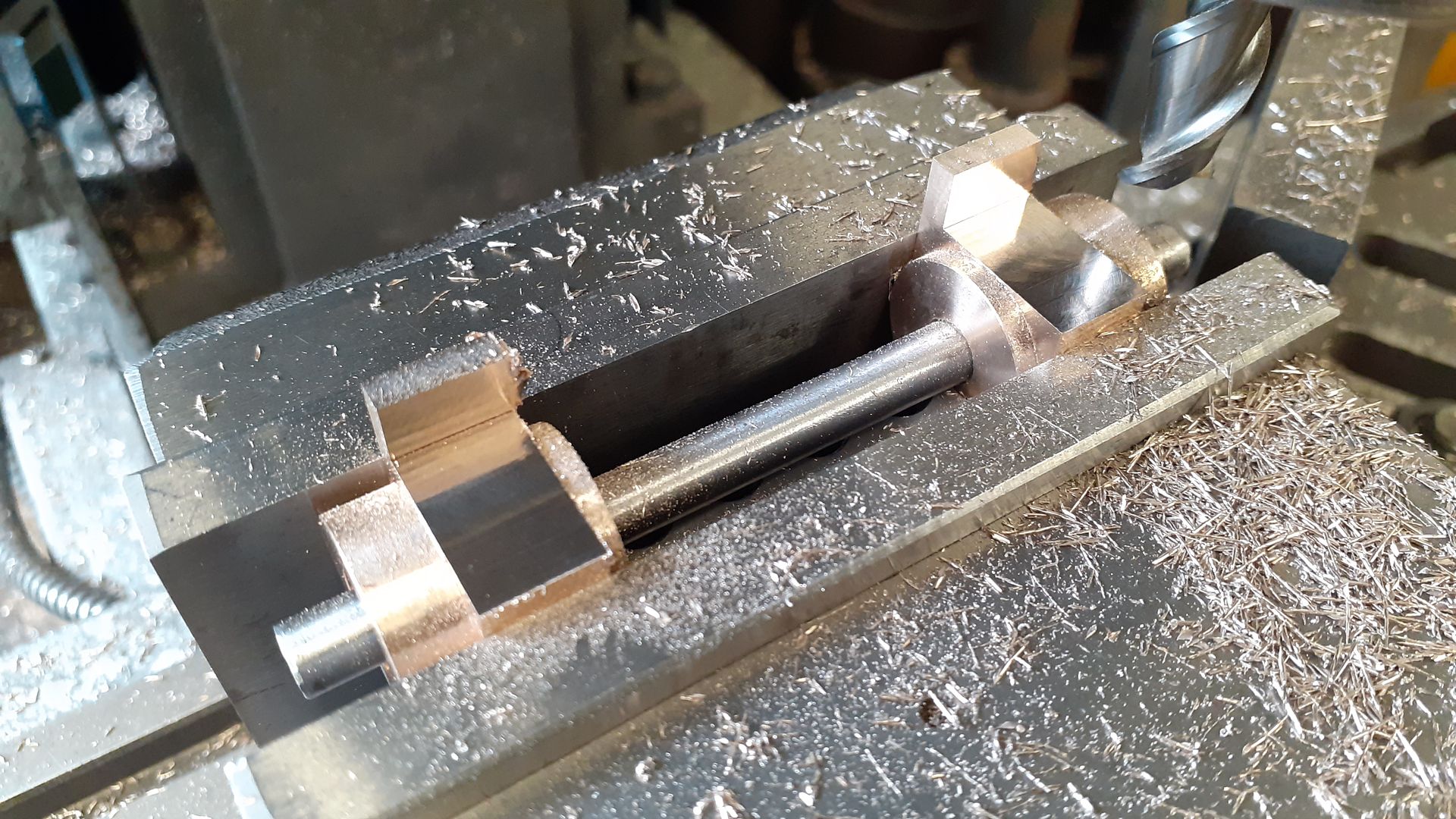

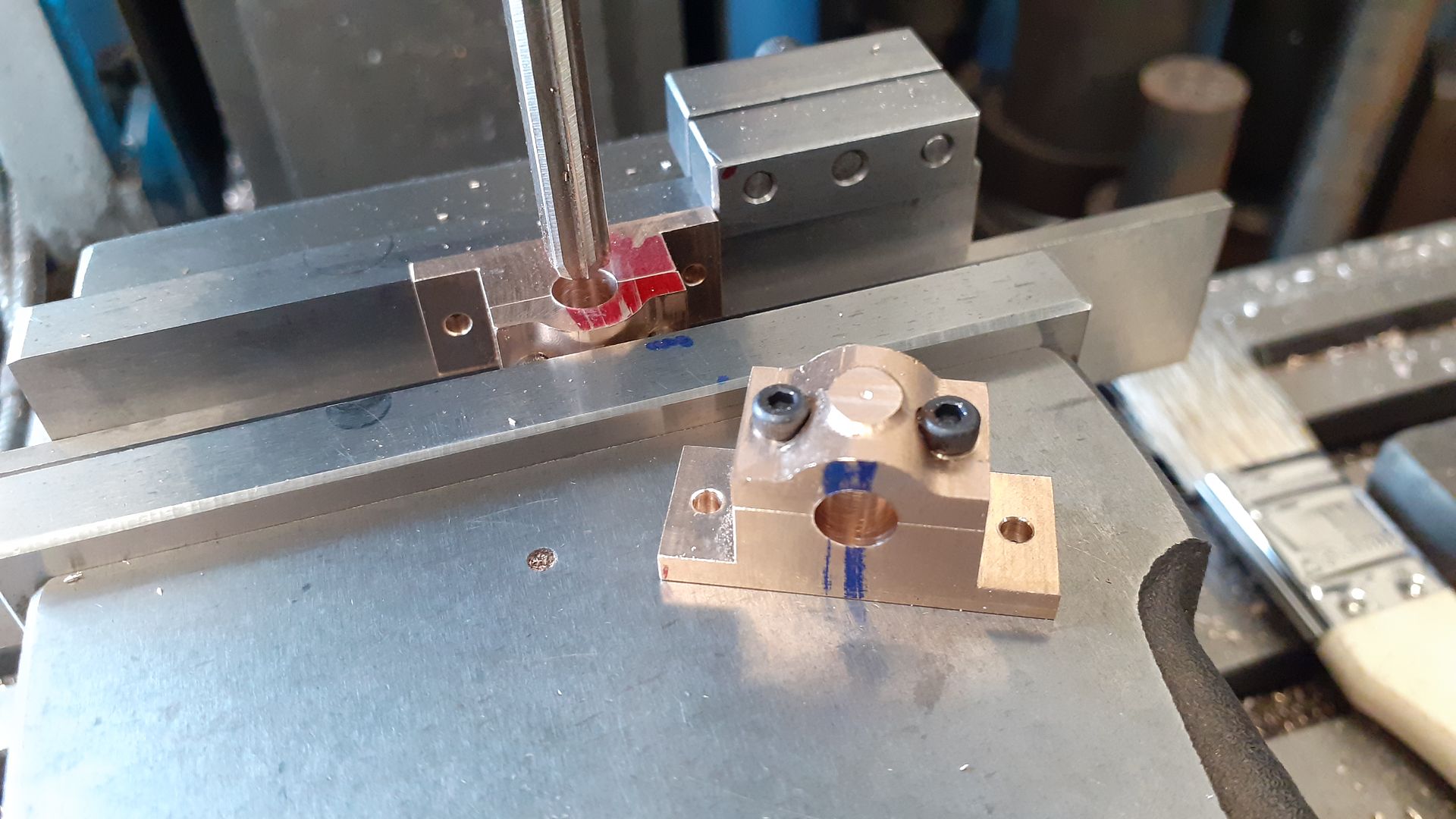

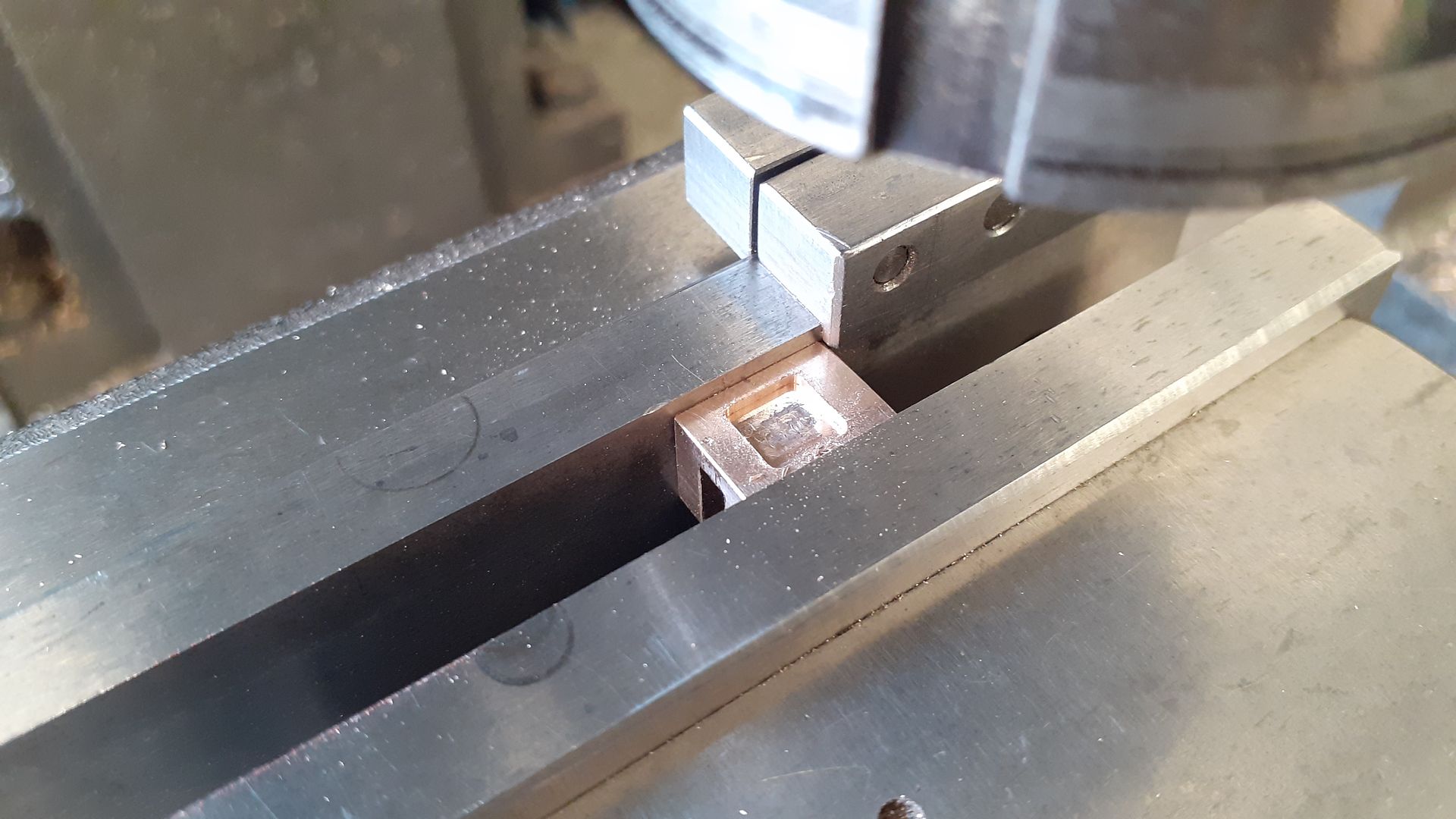

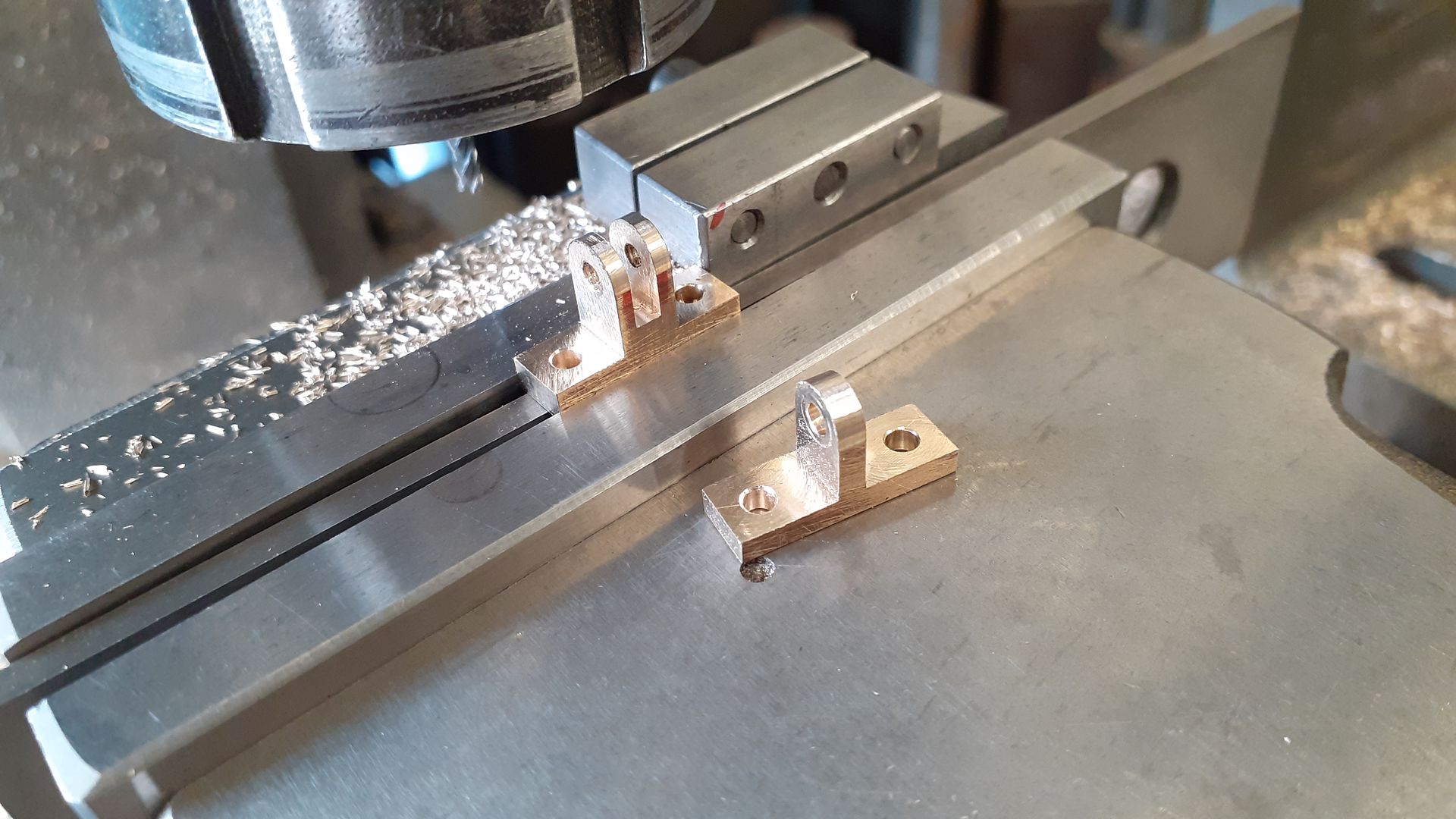
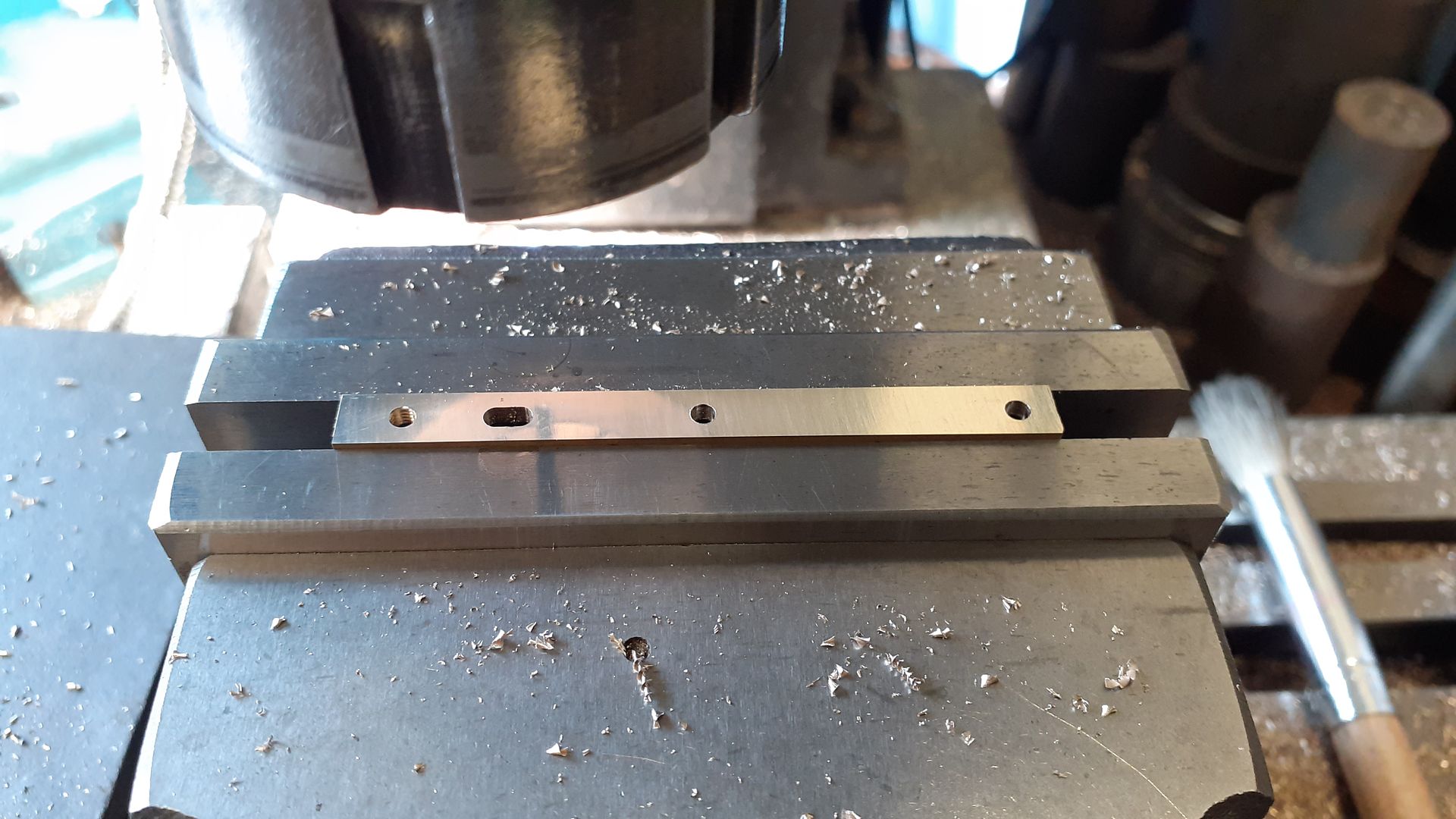
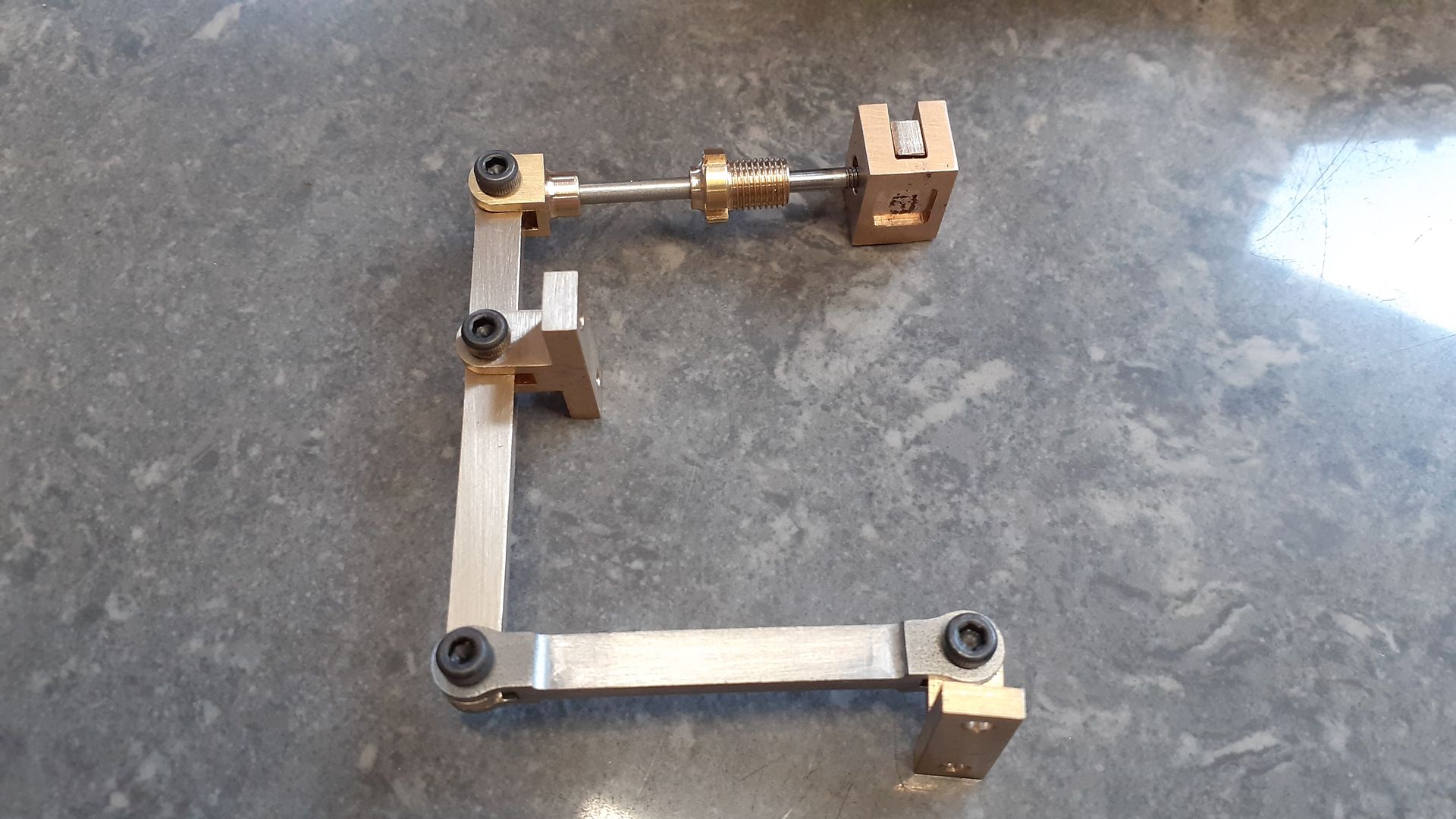
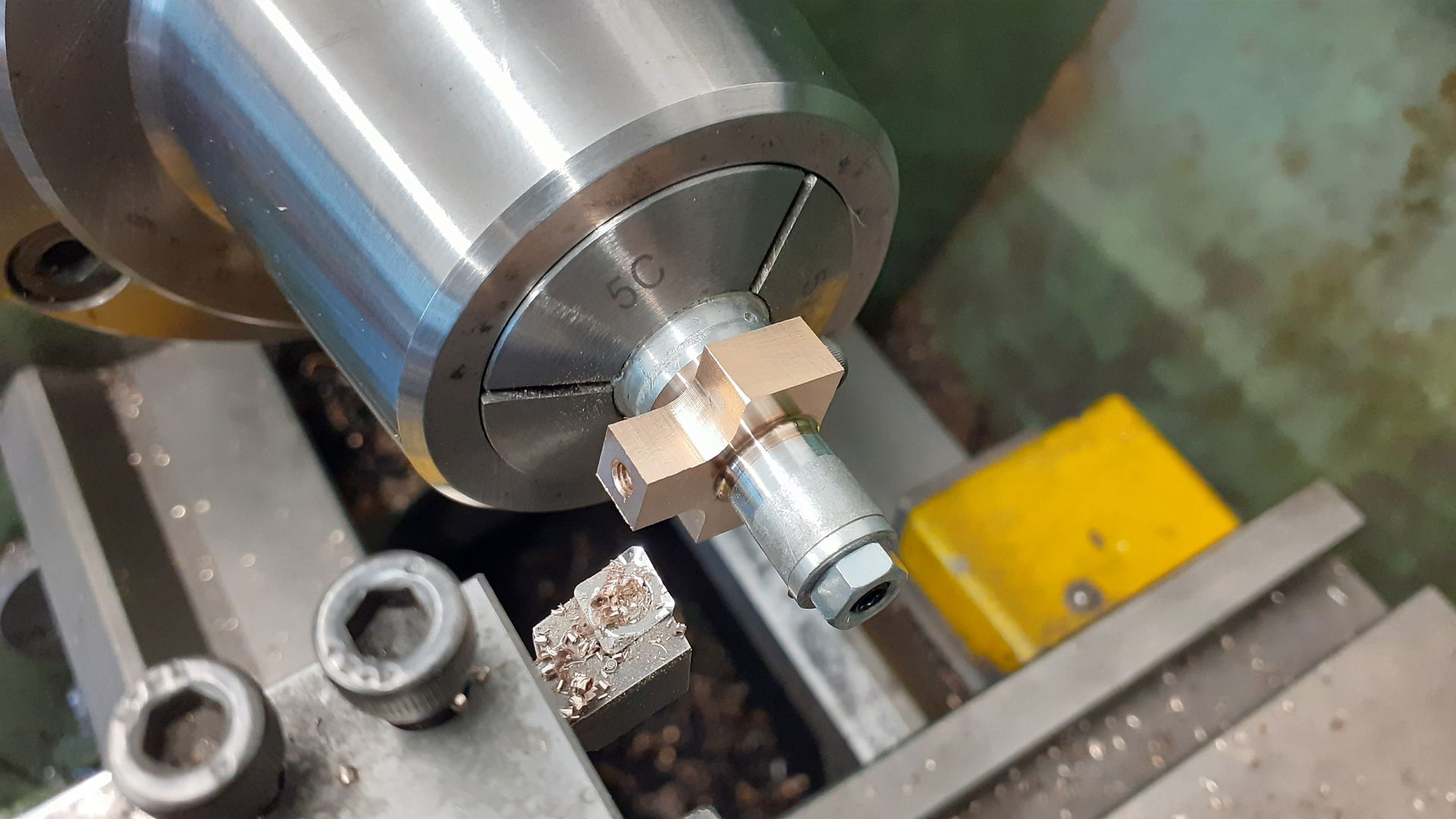
![20230828_085701[1]](https://www.model-engineer.co.uk/wp-content/uploads/sites/4/hm_bbpui/679825/5npbexkgq7mtt9819u18b9wzxxiq9uy4.jpg)
![20230828_120923[1]](https://www.model-engineer.co.uk/wp-content/uploads/sites/4/hm_bbpui/679825/jw2kzn5hns9s5c8qy7xucksm2kiq0uqp.jpg)
![20230828_141931[1]](https://www.model-engineer.co.uk/wp-content/uploads/sites/4/hm_bbpui/679825/fyjvqjf3q7it7z7m6rhdcumiapu9lpgz.jpg)
![20230828_143704[1]](https://www.model-engineer.co.uk/wp-content/uploads/sites/4/hm_bbpui/679825/e8pbgjroaiom3ebfibqsb7qemztkr32b.jpg)
![20230902_120905[1]](https://www.model-engineer.co.uk/wp-content/uploads/sites/4/hm_bbpui/679825/m717xp3od1h5yx84iqld09x4eaj6ls4m.jpg)
![20230903_090011[1]](https://www.model-engineer.co.uk/wp-content/uploads/sites/4/hm_bbpui/679825/u5xuqgm94t29lo4s698qo71fgtpq5iei.jpg)
![20230903_131849[1]](https://www.model-engineer.co.uk/wp-content/uploads/sites/4/hm_bbpui/679825/zs8re4dwxcgq96kshzp6u1z4u0m9su8t.jpg)
![20230904_103145[1]](https://www.model-engineer.co.uk/wp-content/uploads/sites/4/hm_bbpui/679825/rvi29d48yy28yuph9bwu17flfsa756vh.jpg)
![20230904_103157[1]](https://www.model-engineer.co.uk/wp-content/uploads/sites/4/hm_bbpui/679825/88gj02llmyaaouy1k8pl87m3io6sfo2g.jpg)
![dc[1]](https://www.model-engineer.co.uk/wp-content/uploads/sites/4/hm_bbpui/679825/1jb9u6e2pxf84ptzy9dsgzk8fqu17swj.jpg)
![20230831_142434[1]](https://www.model-engineer.co.uk/wp-content/uploads/sites/4/hm_bbpui/684053/5yd0a9kpfndzai4sitzjbym8kz2cfv7x.jpg)
![20230831_150012[1]](https://www.model-engineer.co.uk/wp-content/uploads/sites/4/hm_bbpui/684053/zrcl12tptg1y0qwd9h0fk8k371bj7dsg.jpg)
![20230902_083916[1]](https://www.model-engineer.co.uk/wp-content/uploads/sites/4/hm_bbpui/684053/aa6icnreqf32vqd3dgdoskmk1et18sws.jpg)
![20230906_094406[1]](https://www.model-engineer.co.uk/wp-content/uploads/sites/4/hm_bbpui/684053/p49grtkdn5b1ebkug1jsbnx5cw2m5fw4.jpg)
![20230908_093334[1]](https://www.model-engineer.co.uk/wp-content/uploads/sites/4/hm_bbpui/684053/0xfrij6yhfcrt9fvnclt343idkgct31o.jpg)
![20230908_093344[1]](https://www.model-engineer.co.uk/wp-content/uploads/sites/4/hm_bbpui/684053/n65tcq8tjqspphqz4rdl6jiuyy5a6h81.jpg)
![20230908_105042[1]](https://www.model-engineer.co.uk/wp-content/uploads/sites/4/hm_bbpui/684053/mqajzz08khocmczla5iet9h2x2dlb06m.jpg)
![20230909_080911[1]](https://www.model-engineer.co.uk/wp-content/uploads/sites/4/hm_bbpui/684053/k7xu25v0vfol7tk3v73eqgum47zd6u2z.jpg)
![20230909_080919[1]](https://www.model-engineer.co.uk/wp-content/uploads/sites/4/hm_bbpui/684053/ci7qaznaop6pxpa3qna9ikpkvsi7e92u.jpg)
